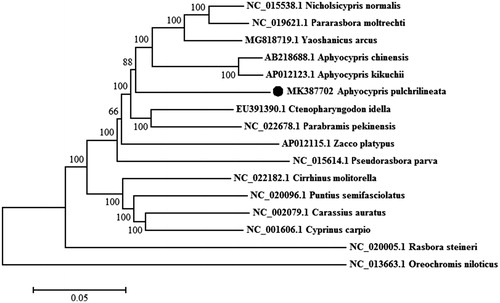Abstract
Aphyocypris pulchrilineata is a miniature cyprinid fish that only found in the streams or the underground river outlet of Hongshui River and Liujiang River, Southwestern China. The complete mitochondrial genome is 16,610 bp in length, consisting of 37 genes coding for 13 proteins, two rRNAs, 22 tRNAs, and one control region with 936 bp long. Phylogenetic analysis using mitochondrial genomes of 16 species showed that the genus Aphyocypris, Yaoshanicus, Pararasbora, and Nicholsicypris clustered as a monophyletic clade with strong supports, and A. pulchrilineata was the most basal species in this clade.
Aphyocypris pulchrilineata, a miniature cyprinid fish, was first found in a stream of the Chengjiang River (belong to Hongshui River), which was located close to the Du’an county, Southwestern China (Zhu et al. Citation2013). To date, there were five effective species in this genus Aphyocypris, namely A. chinensis, A. kikuchii, A. lini, A. amnis, and A. pulchrilineata (Chen Citation2013; Jiang et al. Citation2016). Comparing to the most similar species A. lini, A.pulchrilineata lacked a large black spot on the caudal-fin base (Zhu et al. Citation2013). Because of low population and habitat degradation, most of the species of this genus Aphyocypris were at risk of extinction, including A. pulchrilineata (Jiang et al. Citation2016).
The sample of A. pulchrilineata was collected from the underground river outlet (belong to Liujiang River) located in Liujiang County of Guangxi, China (24°8′43.14′N, 109°2′44.33′E), and its muscle samples were fixed in 95% ethanol and preserved in Liuzhou Aquaculture Technology Extending Station, Liuzhou, China. Total genomic DNA was extracted from the fins through using traditional phenol-chloroform extraction method (Taggart et al. Citation1992). Then, we have sequenced the complete mitochondrial genome of A. pulchrilineata using the Illumina Hiseq4000 platform with de novo strategy (Tang et al. Citation2015) and submitted the genome into GenBank with accession number MK387702.
The mitogenome of A. pulchrilineata was 16,610 bp in size, including 13 protein-coding (PCGs), two ribosomal RNA (rRNA), 22 transfer RNA (tRNA) genes and one control region (D-loop). The gene arrangement and structure were identical to the most vertebrates as previously reported. The nucleotide base composition of A. pulchrilineata was 30.55% A, 16.62% G, 26.59% T, 26.24% C and an AT bias of 57.13%. The ND6 and eight tRNA genes (tRNA-Gln, tRNA-Ala, tRNA-Asn, tRNA-Cys, tRNA-Tyr, tRNA-Ser, tRNA-Glu, and tRNA-Pro) were encoded by the light strand, whereas the remaining genes were encoded on the heavy strand. The typical ATG initiation codon appeared in 13 PCGs except in COI gene, having GTG as the start codon. Besides, the stop codons of 13 PCGs have four types (TAA, TAG, TA-, and T–). The 12S and 16S rRNAs are 961 bp and 1685 bp in length, respectively, located between tRNA-Phe and tRNA-Leu genes and separated by the tRNA-Val gene. The length of 22 tRNAs ranged from 68 bp (tRNA-Cys) to 76 bp (tRNA-Lys) in size, and the D-loop was located between tRNA-Phe and tRNA-Pro with 936 bp long.
To validate the phylogenetic position of A. pulchrilineata, a neighbour-joining(NJ) tree inferred from the whole mitogenome of 15 Cyprinidae species and 1 Cichlidae species (outgroup) was constructed using MEGA 6.06. The phylogenetic results revealed that the genus Aphyocypris, Yaoshanicus, Pararasbora, and Nicholsicypris clustered as a monophyletic clade with strong supports, and A. pulchrilineata was the most basal species in this clade ().
Disclosure statement
No potential conflict of interest was reported by the authors.
References
- Chen XY. 2013. Checklist of fishes of Yunnan. Zool Res. 34:281–343.
- Jiang ZG, Jiang JP, Wang YZ, Zhang E, Zhang YY, Li LL, Xie F, Cai B, Cao L, Zheng GM, et al. 2016. Red list of China’s vertebrates. Biodivers Sci. 24:500–551.
- Taggart J, Hynes R, Prod Uhl P, Ferguson A. 1992. A simplified protocol for routine total DNA isolation from salmonid fishes. J Fish Biol. 40:963–965.
- Tang M, Hardman CJ, Ji Y, Meng G, Liu S, Tan M, Yang S, Moss ED, Wang J, Yang C, et al. 2015. High-throughput monitoring of wild bee diversity and abundance via mitogenomics. Methods Ecol Evol. 6:1034–1043.
- Zhu Y, Zhao Y, Huang K. 2013. Aphyocypris pulchrilineata, a new miniature cyprinid species (Teleostei: Cypriniformes: Cyprinidae) from Guangxi, China. Ichthyol Res. 60:232–236.

